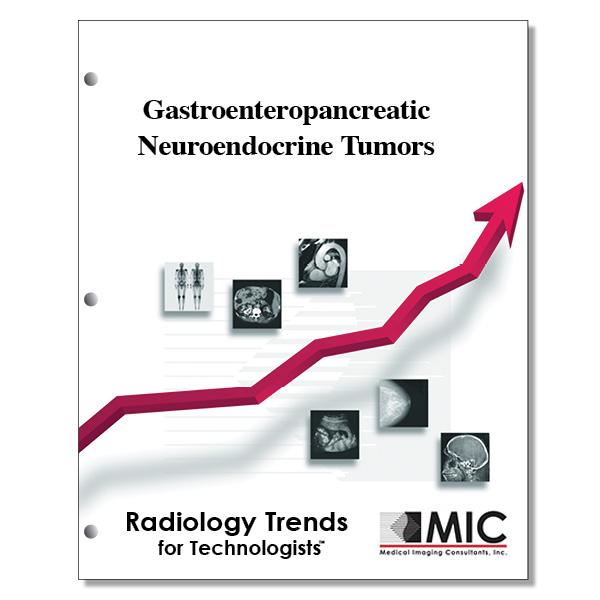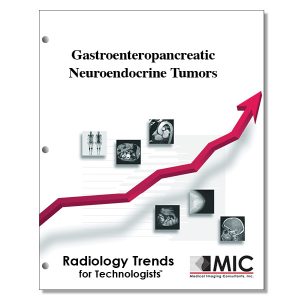

Gastroenteropancreatic Neuroendocrine Tumors
The role of imaging in the diagnosis and management of gastroenteropancreatic neuroendocrine tumors is explored.
Course ID: Q00393 Category: Radiology Trends for Technologists Modalities: CT, MRI, Nuclear Medicine, PET, Radiation Therapy4.5 |
Satisfaction Guarantee |
$39.00
- Targeted CE
- Outline
- Objectives
Targeted CE per ARRT’s Discipline, Category, and Subcategory classification for enrollments starting after May 25, 2023:
[Note: Discipline-specific Targeted CE credits may be less than the total Category A credits approved for this course.]
Computed Tomography: 2.50
Procedures: 2.50
Abdomen and Pelvis: 2.50
Magnetic Resonance Imaging: 2.50
Procedures: 2.50
Body: 2.50
Nuclear Medicine Technology: 2.50
Procedures: 2.50
Endocrine and Oncology Procedures: 2.50
Registered Radiologist Assistant: 3.75
Procedures: 3.75
Abdominal Section: 3.75
Sonography: 2.50
Procedures: 2.50
Abdomen: 2.50
Radiation Therapy: 4.00
Patient Care: 2.00
Patient and Medical Record Management: 2.00
Procedures: 2.00
Treatment Sites and Tumors: 2.00
Outline
- Introduction
- Risk Factors and Etiology
- Diagnosis
- Pathologic Classification and Staging
- Imaging Techniques
- Noninvasive Techniques: Morphologic Imaging
- Noninvasive Techniques: Functional Imaging
- Invasive Techniques
- Role of Imaging in Tumor Detection and Characterization
- Pancreatic NETs
- Extrapancreatic NETs
- Detection of Unknown Primary NETs
- Imaging in Metastatic Disease
- Treatment
- Follow-up
- Screening in High-Risk Patients with Genetic Defects
- Conclusions
Objectives
Upon completion of this course, students will:
- understand the difference between the terms prevalence and incidence
- understand why prevalence is the preferred statistic when the focus is on the overall number of cases surviving in a population
- understand how the divisions of the gastrointestinal tract are delineated
- identify the divisions of the gastrointestinal tract
- be familiar with the GEP-NET geographic distribution throughout the world
- know the GI tract location having the highest percentage of NET occurrence
- identify the essential process(es) involved with GEP-NET management and treatment planning
- be familiar with the tumor suppression proteins of the complex genetic syndromes associated with GEP-NETs
- be familiar with the genes of the complex genetic syndromes associated with GEP-NETs
- identify the possible patient problems from Zollinger-Ellison syndrome
- be familiar with the most commonly used neuroendocrine serum marker for GEP-NET diagnosis
- know how the various proton-pump inhibitors differ
- be familiar with the initial WHO tumor classification criteria
- know the ENETS tumor classification criteria
- be familiar with TNM staging for pancreatic NETs
- be familiar with TNM staging for NETs of the stomach, small intestine, colon, and rectum
- be familiar with the methods of Ki-67 analysis
- know the required components for appropriate care of GEP-NET patients
- know the general limitation of trans-abdominal ultrasound in pancreas evaluations
- identify the reasons for multi-detector CT being the most common initial imaging test to evaluate for suspected pathologic conditions in the abdomen
- know the advantages of MR imaging over CT imaging
- identify the somatostatin analog considered to be the reference standard for NET functional imaging
- understand the recognized limitations of SRS
- be familiar with advantages of PET somatostatin analog imaging over SRS
- know where FDG PET has limited value in NET evaluation
- be familiar with the drawbacks of endoscopic ultrasound for NET evaluations
- know the term for the process of separating a disease from others having similar signs and symptoms
- understand the heat-damaged 99mTc red blood cell procedure for functional imaging of accessory spleen tissue
- be familiar with the differences of functional and nonfunctional pancreatic NETs
- be familiar with how aggressive nonfunctional pancreatic NETs demonstrate
- be familiar with how pancreatic NETs appear on MR imaging
- know what procedure can benefit in IPAS diagnosis when MR fails
- know the procedure that can be the most sensitive for pancreatic NET detection
- be familiar with the reasons why preoperative detection of a primary NET in the gastrointestinal tract is challenging
- be familiar with the different types of gastric NETs
- identify the best contrast medium for visualizing type I and II gastric NETs on contrast-enhanced CT imaging
- know the roles that endoscopy and biopsy play in duodenal NETs
- be familiar with how Ileal NETs manifest on CT/MR enterography
- be familiar with some difficult differential diagnosis for ileal NETs
- be familiar with the features and manifestations of colon NETs
- identify the most common sites for NET metastases
- know the single most important factor for small bowel NETs that influences patient survival and prognosis
- identify the factors which improve the detection and characterization ability of MR imaging for malignant liver lesions
- identify the situation in which radical surgery along with resection of draining lymph nodes is recommended
- be familiar with the GEP-NET screening methods for high-risk patients with genetic defects
